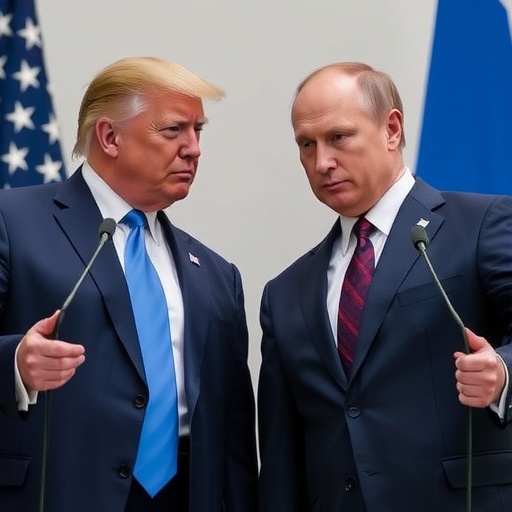Trump Delays Putin Summit as US-Russia-Ukraine Diplomacy Edges Toward Ukraine War Breakthrough
In a stunning twist to international relations, former President Donald Trump has postponed a highly anticipated summit with Russian President Vladimir Putin, amid reports that US, Russian, and Ukrainian officials are on the verge of a diplomatic breakthrough to end the protracted Ukraine war. Sources close to the negotiations reveal that the delay, originally scheduled for next month in a neutral European capital, stems from rapid advancements in backchannel talks that could reshape the geopolitical landscape of Eastern Europe.
The announcement comes at a critical juncture, with the Ukraine war entering its third year since Russia’s full-scale invasion in February 2022. Over 500,000 military casualties have been reported on both sides, according to estimates from the United Nations and Western intelligence agencies, while the conflict has displaced more than 6 million Ukrainians and triggered a global energy crisis. Trump‘s involvement, leveraging his past rapport with Putin, has injected fresh momentum into stalled diplomacy efforts led by the Biden administration.
“We’re closer than ever to a deal that stops the bloodshed,” a senior US diplomat told reporters anonymously, emphasizing the delicate balance of concessions under discussion. This development underscores Trump’s enduring influence on foreign policy, even as he campaigns for a potential 2024 return to the White House.
Behind the Scenes: Why the Trump-Putin Summit Was Abruptly Shelved
The postponement of the Trump-Putin summit has sent ripples through diplomatic circles, with insiders attributing the decision to unexpectedly positive signals from ongoing trilateral discussions involving the US, Russia, and Ukraine. Originally envisioned as a high-stakes face-to-face meeting to hammer out peace terms, the event was meant to build on Trump’s recent public overtures, where he vowed to resolve the Ukraine war “in 24 hours” if re-elected.
According to reports from Reuters and other outlets citing State Department sources, the delay allows negotiators more time to iron out preliminary agreements without the pressure of a public spectacle. “Rushing into a summit now could derail the fragile progress we’ve made,” the anonymous diplomat added. Putin’s team, meanwhile, has echoed this sentiment, with Kremlin spokesperson Dmitry Peskov stating in a televised address, “President Putin remains committed to dialogue, but timing is everything in matters of such gravity.”
This isn’t the first hiccup in Trump-Putin interactions. Their last in-person meeting occurred in Helsinki in 2018, where Trump famously sided with Putin over US intelligence on election interference. Fast-forward to today, and the context is the Ukraine war’s devastating toll: Ukraine’s economy has shrunk by 30% since the invasion, per World Bank data, while Russia’s military spending has surged to 6% of GDP, straining its sanctions-hit finances.
Trump’s decision to postpone also aligns with his strategy to avoid entanglement in what he calls “endless wars.” In a recent Fox News interview, he remarked, “I told Putin we’d talk, but only when it counts. We’re making real headway without the cameras rolling.” This approach has drawn mixed reactions, with some praising the pragmatism and others questioning if it’s a stalling tactic amid his legal battles.
Tripartite Talks Gain Steam: Key Concessions Shaping Ukraine War Diplomacy
As the Trump-Putin summit takes a backseat, the real action unfolds in discreet tripartite talks—US-Russia-Ukraine diplomacy—that have reportedly advanced to drafting stage. Ukrainian Foreign Minister Dmytro Kuleba confirmed in a Kyiv press conference that “substantive proposals” are on the table, focusing on territorial compromises, security guarantees, and reconstruction aid.
Central to these negotiations is Russia’s insistence on recognition of annexed territories like Crimea and parts of Donbas, which encompass about 20% of Ukraine’s pre-war landmass. In exchange, the US is pushing for ironclad NATO non-expansion pledges for Ukraine and the lifting of certain Western sanctions on Russia. “Diplomacy here means tough choices,” Kuleba said, quoting President Volodymyr Zelenskyy: “Peace must come with justice, not capitulation.”
Statistics highlight the urgency: The war has caused over $400 billion in damage to Ukraine’s infrastructure alone, according to a joint UN-EU assessment, with daily artillery exchanges averaging 60,000 shells as of late 2024. On the Russian side, Putin faces domestic pressure from a war-weary population and battlefield setbacks, including the recent Ukrainian incursion into Kursk region that captured 1,000 square kilometers of Russian soil.
US Special Envoy for Ukraine Peace, Keith Kellogg—a retired general and Trump advisor—has been pivotal, shuttling between Washington, Moscow, and Kyiv. In leaked memos obtained by The New York Times, Kellogg outlines a phased approach: immediate ceasefire, followed by monitored withdrawals, and long-term economic incentives like access to frozen Russian assets worth $300 billion for Ukraine’s rebuilding.
Experts like Fiona Hill, former National Security Council official, note in a recent Atlantic op-ed that “Trump’s outsider status could unlock doors that career diplomats can’t.” Yet, skeptics warn of Putin’s history of bad-faith negotiations, referencing the failed Minsk agreements of 2014-2015 that preceded the full invasion.
Global Powers React: Allies and Adversaries Weigh In on Potential Breakthrough
The prospect of a diplomatic solution to the Ukraine war has elicited a spectrum of responses from global stakeholders, with NATO allies urging caution and emerging powers like China and India expressing cautious optimism. European Union foreign policy chief Josep Borrell tweeted, “Any deal must uphold Ukraine’s sovereignty; we’re monitoring closely to ensure no shortcuts undermine our security.”
In Brussels, where much of the funding for Ukraine’s defense—totaling over $100 billion from the US and EU combined—originates, leaders are divided. German Chancellor Olaf Scholz praised the diplomatic push, stating in parliament, “Ending this war through talks is our shared goal, and Trump’s involvement adds a new dynamic.” Conversely, Polish Prime Minister Donald Tusk voiced concerns, warning that “concessions to Putin could embolden aggression elsewhere in Europe.”
Across the Atlantic, bipartisan support in Washington is tempered by election-year politics. Senate Foreign Relations Committee Chair Bob Menendez (D-NJ) commended the efforts but stressed, “Verification mechanisms are non-negotiable.” Republican Senator Lindsey Graham, a Trump ally, added, “If this leads to peace without weakness, it’s a win for America first.”
Further afield, China’s Foreign Ministry spokesperson Wang Wenbin noted Beijing’s role as a mediator, having hosted Zelenskyy and Russian officials earlier this year. “We support all paths to de-escalation,” Wang said, amid reports of Beijing supplying dual-use tech to Russia. India, abstaining from UN votes on the Ukraine war, has positioned itself as a neutral broker, with Prime Minister Narendra Modi recently calling Putin to congratulate him on potential progress.
The economic stakes are immense: The war has driven up global food prices by 20-30%, per FAO data, exacerbating hunger in Africa and the Middle East. A breakthrough could stabilize markets, with oil prices potentially dropping 10-15% if sanctions ease, analysts at Goldman Sachs predict.
Path Forward: What Lies Ahead for Trump, Putin, and Ukraine War Resolution
Looking ahead, the postponed Trump-Putin summit could be rescheduled within weeks if current diplomacy yields a framework agreement. US officials anticipate a virtual follow-up involving Zelenskyy by mid-November, aiming to formalize a ceasefire before winter sets in—a season that historically favors defensive positions in Ukraine’s muddy terrain.
Reconstruction plans are already underway, with the World Bank estimating a $500 billion need over the next decade. Frozen Russian assets could fund much of this, but legal hurdles in G7 nations remain. Trump has teased his vision in rallies: “We’ll bring peace, prosperity, and make Europe pay its fair share—no more American blood or treasure.”
Putin, facing internal dissent including rare protests in Moscow over mobilization, may see this as a face-saving exit. Ukrainian resilience, bolstered by Western arms like HIMARS systems that have destroyed 20% of Russia’s Black Sea Fleet, gives Kyiv leverage at the table.
Ultimately, success hinges on trust-building measures, such as prisoner exchanges—over 1,000 already swapped this year—and international monitoring by the OSCE. If achieved, this diplomatic pivot could avert further escalation, including nuclear saber-rattling from Putin. As one European diplomat put it, “The Ukraine war’s endgame is here; now it’s about crafting a legacy of peace rather than perpetual conflict.”
The world watches breathlessly, hoping that Trump’s bold diplomacy with Putin translates into a lasting resolution for Ukraine.










